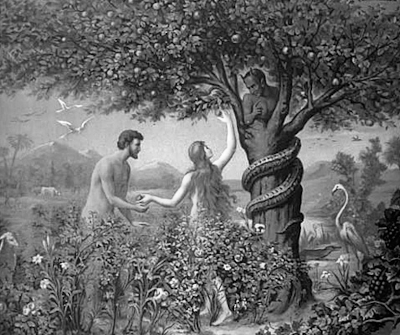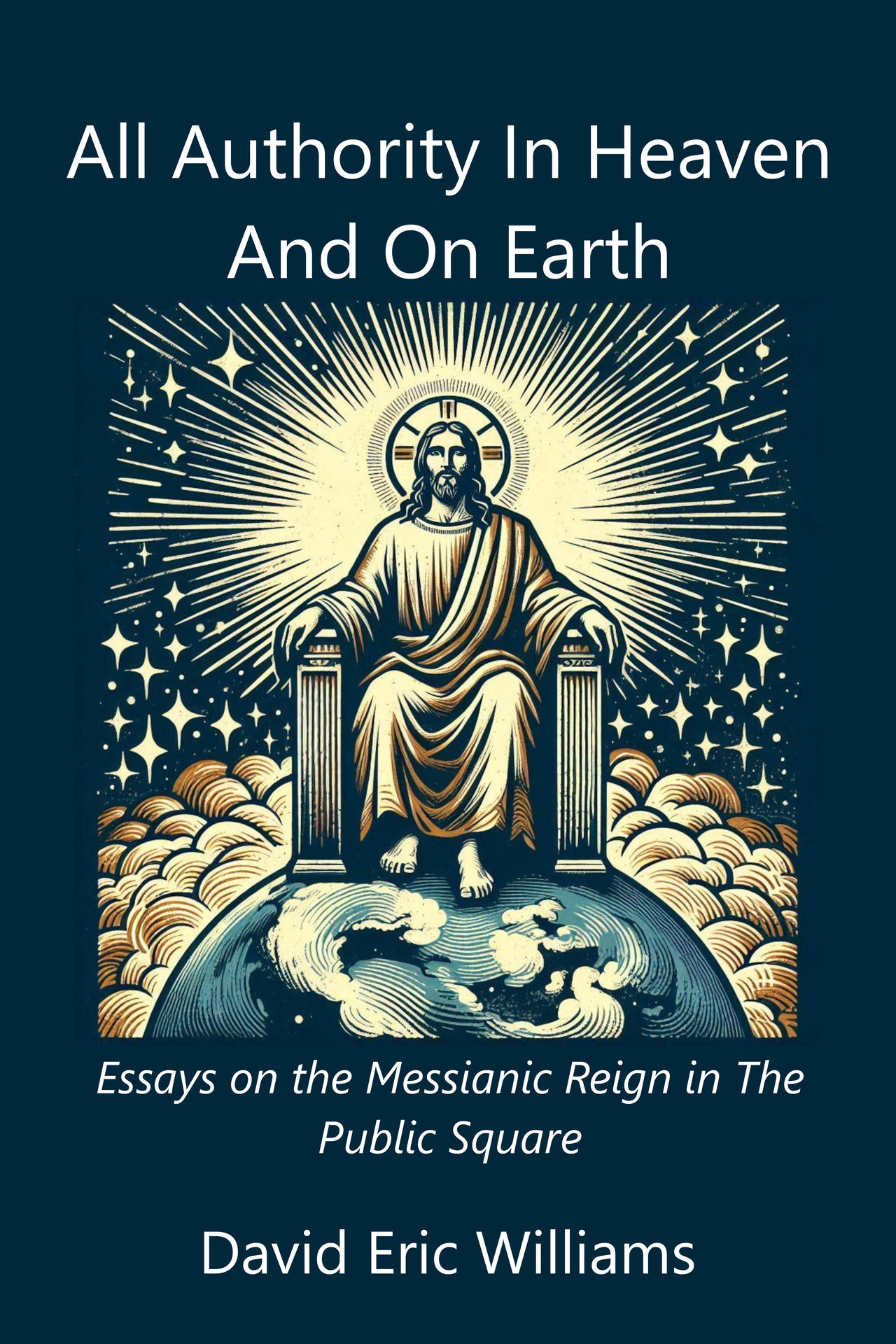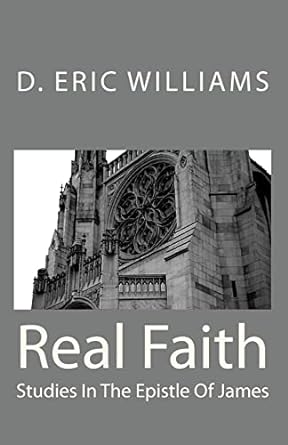The Adamic Covenant and The Two Trees
© 06.25.19 By David Eric Williams
 While the term "covenant" is never used in the Genesis account concerning Adam and his relationship to God it is generally recognized that a covenant did exist between God and the first man. Among evangelicals it is sometimes assumed the Adamic covenant was a covenant of works. For instance, the Westminster Confession of Faith says, "The first covenant made with man was a covenant of works, wherein life was promised to Adam, and in him to his posterity, upon condition of perfect and personal obedience."1
While the term "covenant" is never used in the Genesis account concerning Adam and his relationship to God it is generally recognized that a covenant did exist between God and the first man. Among evangelicals it is sometimes assumed the Adamic covenant was a covenant of works. For instance, the Westminster Confession of Faith says, "The first covenant made with man was a covenant of works, wherein life was promised to Adam, and in him to his posterity, upon condition of perfect and personal obedience."1
Yet, this position rests upon an inadequate understanding of the relationship God established with Humanity at creation. Indeed, in the following paragraphs it will be shown that the Adamic or Edenic covenant was a covenant of grace not unlike the Abrahamic covenant with the two trees at the center of the garden representative of covenant life and responsibility.
Characteristics of the Adamic/Edenic Covenant
The relationship between God and Adam portrayed in Genesis is not a covenant of works since, "meritorious salvation before the Fall is not in question because Adam was already saved."2 Moreover, the description of humanity (male and female) in Genesis 1:26-28 recommends against viewing the original covenant as a covenant of works. In other words, the description of man and his responsibilities as recorded in Genesis give us a hint of the nature of the Adamic or Edenic covenant.
In Genesis 1:26-28 we read,
Then God said, "Let us make human beings in our image, to be like us. They will reign over the fish in the sea, the birds in the sky, the livestock, all the wild animals on the earth, and the small animals that scurry along the ground." So God created human beings in his own image. In the image of God he created them; male and female he created them. Then God blessed them and said, "Be fruitful and multiply. Fill the earth and govern it. Reign over the fish in the sea, the birds in the sky, and all the animals that scurry along the ground" (Genesis 1:26-28).3
The designation of Mankind as the "image of God" points to the idea of one who "is a physical manifestation of divine (or royal) essence that bears the function of that which it represents."4 While this description is applied to Adam and Eve in 1:27 (male and female) it is not limited to the first couple. Rather, "in God's eyes, all of mankind is royal."5
Clearly, representation implies a sovereign. Thus, the Genesis record portrays God as "absolutely sovereign over the creation."6 It is God who is the "Originator, Preserver, Governor, and Provider of the Creation."7 This God, who created and sustains all things (cf. Colossians 1:16-17), chose to create humanity to represent him in the created realm.
Moreover, "God is more than creator, he is law-giver."8 God as law-giver does not emerge in the creation account only in Genesis 2:15-17. Rather, from the beginning of the creation record we see that God,
divides the light from darkness and the land from sea, and he names them. He appoints the stars for signs and for seasons. The animate creation is told be fruitful and multiply. Man is to subdue the earth, and the seventh day is hallowed. God sets bounds for the natural order and specifies the roles of the species within it. With this goes the corollary that all creatures will fulfill the divinely appointed role only if they adhere to God's directive.9
It is important to understand that God as lawgiver defines the actions of his representative. Adam is told to "Fill the earth and govern it. Reign over the fish in the sea, the birds in the sky, and all the animals that scurry along the ground" (Genesis 1:28). All of this implies a law already established by God. Granted, Genesis does not provide any detail whatsoever; we can only assume Adam knew (at least in part) what it meant to govern and reign over God's creation. Thus, Adam new the law of God in some fashion and how to implement it.
The most prominent expression of law in the early portion of Genesis is found in the second chapter: "But the LORD God warned him, 'You may freely eat the fruit of every tree in the garden - except the tree of the knowledge of good and evil. If you eat its fruit, you are sure to die'" (Genesis 2:16-17). With this specific law given to Adam, we are introduced to the concept of punishment. Adam is told he cannot eat of a particular tree and if he does he will suffer death. The punishment of death should be understood in two ways. To begin with, verse seventeen "is underscoring the certainty of death, not chronology" and therefore it "conveys ...the announcement of the death sentence by divine Royal decree" without providing a certain time frame.10 In other words, the punishment of death is presented as the eventual doom of Adam if he violates God's command.11
In addition, we must understand the Bible explains that death is - perhaps primarily - separation from God. Jesus himself said, "this is the way to have eternal life - to know you, the only true God, and Jesus Christ, the one you sent to earth" (John 17:3). Therefore, "eternal life is simply the knowledge of God."12 This is more than "head knowledge" but is knowing in the sense of intimacy. It is significant that the Greek term used to describe knowing God in John 17:3 is used in the Septuagint version (Greek translation, c. 200 BC) of Genesis 4:1. In Genesis chapter four we are told that "Adam knew Eve his wife and she conceived" (New King James Version). The Greek in John 17:3 and Genesis 4:1 is a form of ginosko and means to "know, understand, comprehend" and to have an intimate relationship of trust.13 This does not imply there is a sexual aspect to our knowledge of God as described in John. Rather, it heightens our awareness of the depth of relationship. In any case, the death experienced by Adam and Eve was immediate in that intimate fellowship with God was broken. No longer were Adam and Eve allowed in the sanctuary of the Garden,14 but were forced to dwell apart from God (Genesis 3:24).
Nevertheless, this does not signal the end. Not only does God provide garments for Adam and Eve (Genesis 3:21), the subsequent narrative of Genesis makes it clear that God maintained a relationship with Adam and his offspring. While it is true that not all of Adam's progeny remained in a "knowing" relationship with God it is clear that Adam, Able, Seth and others continued in fellowship with their Creator (Genesis 4:1, 4, 25-26 etc.). In other words, God's covenant relationship with mankind did not come to an end with the disobedience of Adam and Eve.
The presence of blessings is clearly evident in the relationship in the placement of Adam and Eve in the Garden (Genesis 2:8, 15). It is also manifest in the creation of Eve for Adam (Genesis 2:22). The fellowship they both enjoyed with their Creator was also a blessing.
An Initial Summary of the Adamic/Edenic Covenant
This examination of the relationship between Adam (and Eve) and God, has revealed certain distinctives. In the first place, it is evident that God is portrayed as the sovereign Creator and Lord of the universe. Also, Adam (and Eve) were created to act as representatives of God in his created realm. It is clear that God is the lawgiver and that he intended his creation to function according to natural and moral laws. The presence of law implies punishment and blessing. It has been shown that blessings were present from the beginning of creation and that punishment came as a result of Adam and Eve's disobedience. Finally, the relationship between Adam and God was damaged but it did not come to an end. Therefore, the inference is that there was a built in continuity in the relationship.
Identifying the Features of the Adamic Covenant
If there is a commonality between the Adamic and Abrahamic covenants, there should be an identifiable correlation in the salient covenant features. In order to make this connection, it is important to clearly specify the main points of the covenant relationship.
Theologian Meredith Kline proposed years ago that "Sinaitic and other divine covenants of Scripture" were like the ancient near eastern Suzerain treaties.15 Kline determined the biblical covenant(s) included five elements as did the Suzerain treaties: a preamble, an historical prologue, stipulations, sanctions and succession, or covenant continuity.16 While Kline's thesis was a breakthrough in biblical study, there was room for improvement.
Over twenty years after Kline's insights appeared, Ray Sutton published That You May Prosper, refining and expanding Kline's work. Perhaps the most useful adjustment was the remaking of the five point structure. Sutton determined the covenant model was best outlined as transcendence, hierarchy, ethics, sanctions and continuity.17 The essence of these can be understood in a variety of terms. In this study, the five points are identified as sovereignty, representation, law, blessing and punishment, and continuity.
The significance of associating the Adamic covenant with other biblical covenants is that God has exhibited an unwavering consistency in his relationship to man over time. As this paper will show, the Adamic covenant and the Abrahamic covenant both display the five point structure detailed by Kline and Sutton. Moreover, recognizing the structure of the Adamic covenant helps us to understand the significance of the tree of life and the tree of the knowledge of good and evil.
The Two Trees
References in Genesis to the Tree of Life and the Tree of the Knowledge of Good and Evil are spare of details. The Tree of the Knowledge of Good and Evil is mentioned only two times in the entire Bible (Genesis 2:9, 17). References to the Tree of Life occur in the Bible outside Genesis but without detailed explanation. To better understand the Adamic covenant, it is important to grasp the significance of the two trees at the center of the garden.
The Tree Of Life
The Tree of Life was sacramental "in the broad sense of the word, and [was} ...the physical means of a spiritual transaction."18 Specifically, it represented fellowship with God and the blessings of long life when lived in obedience to God. In that way it "extends life rather than instantly grants immortality."19 Hence, the tree of life represented communion with God and the life and life more abundantly that comes with an unsullied relationship with the Creator. In addition, it is important to note that "the tree was not forbidden to Adam and Eve, and there is no reason to argue that he did not eat from it. But when they were cast out of the garden, they were forbidden access to the tree."20
This understanding of the tree of life is reinforced by the judgment of God recorde in Genesis 3:22-24. There it says God expelled Adam and Eve from the garden so that they could not partake of the tree of life and "live forever." On the face of it this appears to say that eating of the tree would have somehow granted eternal life. Yet it has tentatively been established that the text does not indicate the tree provided immortality. Indeed, Genesis 3:22 can be understood to say that if Adam and Eve (continued) to eat of the tree of life they would "eat and live as long as they live" or to "eat and have life as long as they live."21 This understanding is in keeping with the sacramental nature of the Tree of Life. Again, it represented "the fellowship of God's presence"22 and his favor. Therefore, the concern of God was that man would continue to partake of the covenant sacrament and receive the blessings associated with it even though he had violated the terms of the covenant. God's concern was about eating of the tree in an unworthy fashion rather than eating and gaining eternal life through some inherent quality of the tree.23
The Tree of the Knowledge of Good and Evil
Likewise, the Tree of the Knowledge of Good and Evil did not have an intrinsic quality it was able to bestow and thus rectify some attribute deficient in Adam and Eve. Here again the tree is representative. Indeed, the key to understanding what the Tree of the Knowledge of Good and Evil was about is found in the temptation offered by the serpent. The serpent said, "God knows that your eyes will be opened as soon as you eat it, and you will be like God, knowing both good and evil" (Genesis 3:5). The significance of the temptation is to "be like God." Eve and Adam were tempted to decide for themselves what was right and wrong. In other words, they sought to establish themselves as their own gods. Therefore, "what is forbidden to man is the power to decide for himself what is in his best interest and what is not. This decision God has not delegated to the earthling. … When man attempts to act autonomously he is indeed attempting to be godlike."24
Yet, it is possible to be more specific. The moral autonomy represented by the Tree of the Knowledge of Good and Evil is judicial.25 This view is supported by a reading of the Old Testament. For, there are "many OT passages where good and evil is essentially a legal idiom meaning to formulate and articulate a judicial decision."26 For instance, in Genesis 24:50, "Laban is unable to say bad or good to the servant Abraham has sent to Laban to obtain a wife for Isaac."27 In other words, Laban has no say in the decision concerning whether Rebecca remains at home or leaves to be the wife of Isaac. A similar situation occurred when Jacob secretly left Laban and was later pursued by his father-in-law. Just when Laban caught up with Jacob the text says "God had come to Laban the Syrian in a dream by night, and said to him, 'Be careful that you speak to Jacob neither good nor bad'" (Genesis 31:24). Again, Laban is warned to refrain from acting as a judge concerning Jacob's behavior.28
This understanding of the Tree of the Knowledge of Good and Evil indicates that the prohibition on eating of the tree was temporary. The Bible shows that to know good and evil has to do with the capacity to discriminate. This of course applies to judicial actions as well as general decisions concerning right and wrong. "This capability is lacking in children" and does not "suggest that the subjects do not know anything or that they are morally destitute, only that their ability to discern what is in their best interest is lacking."29 Specifically, it refers to an immature state when one is not allowed to make independent decisions (cf. Deuteronomy 1:39). Therefore, it is likely that humanity would have been granted the privilege of eating of the Tree of the Knowledge of Good and Evil at a later date. Even then mankind would not have exercised complete autonomy. Indeed, although Christians will one day judge the world and angels (1 Corinthians 6:2-3), they will do so under the authority of Christ himself.30
Initial Review of the Adamic Covenant Structure and The Two Trees
Like other covenants described in Scripture, the Adamic covenant has characteristics similar to the ancient suzerainty treaties as described by Meredith Kline. Thus, there is a sovereign (God himself), a representative of the sovereign (Adam and Eve) and a law code, both in the organization of the universe and a moral law to guide Adam and Eve. In addition, there is evident blessing along with punishment for disobedience. Lastly, there is a provision for continuity within the covenant relationship between God and man.
The trees at the center of the garden were sacramental or representative. Neither tree carried the ability to bestow the quality associated with its name on those who ate of its fruit. Instead, the attributes of "life and life more abundantly" and judicial authority were gracious gifts to be given by God directly. Therefore, it seems safe to conclude the two trees were not unlike ritualistic furnishings found in later expressions of the covenant.
The Relationship between the Adamic and Abrahamic Covenants
A watchful reading of Scripture makes it clear there are only two covenants mentioned in the Bible; the old covenant and the new covenant.31 While it is true the Bible talks about covenants between God and Noah, Abraham, Israel, and David, these concern the confirmation of an already existing covenant. For instance, regarding the covenant between God and Noah, the Bible says, "I [God] will confirm my covenant with you. So enter the boat - you and your wife and your sons and their wives" (Genesis 6:18, brackets added). "Confirm" is a correct translation of the Hebrew word qum32 and "is used of ratifying pre-existing words (Deut. 9:5), promises (2 Sam. 7:25), threats (Jer. 30:24), oaths (Gen. 26:3, vows (Num. 30:14), as well as covenants."33
In addition, when in Genesis chapter 15 it says, "So the LORD made a covenant with Abram that day" (Genesis 15:18a), it is best, in this case, to understand the Hebrew word berit as an assurance rather than a covenant. In a covenant relationship there are obligations imposed on both parties. However, "nothing … in this chapter is imposed on Abram. He is free of any obligations."34 Thus, rather than translating berit as "covenant" it should be translated by "something that captures the broader nuances" of the word, something like, "on that day Yahweh gave Abram the solemn assurance."35
All of this is said to clarify that there was one covenant between God and his people previous to the establishment of the new covenant in Jesus Christ. Therefore, when God initiated a relationship with Abram it was on the basis of the same (old) covenant he had made with Adam and then confirmed with Noah. The covenant God confirmed with Abraham verified God as the sovereign (Genesis 17:1), established Abram/Abraham as the new representative of God on earth (Genesis 12:2, 17:6), demanded obedience of Abraham and his prodigy (Genesis 17:1, 10-13, 18:19), promised blessings for obedience and punishment for disobedience (Genesis 12:2-3, 17:14), while guaranteeing continuity of the covenant (Genesis 17:7, 18:19).
Perhaps the most weighty link between Adam and Abraham is the connection of covenant with creation. Throughout Scripture we see covenant and creation tied together. Additionally, the blessings of a covenant relationship with God are meant to be mediated by the covenant head. Adam and Eve were told to take dominion. This was a blessing in that it "indicates the functions that people will have as a result of the role to which they were created."36 The blessing of dominion was supposed to entail the extension of Edenic attributes throughout the whole earth.37 As a new covenant head - a new Adam - Noah had a commission similar to the first Adam. Abram was also a "new Adam" of a fresh administration of the covenant. This is why God sought to "create a new being [to] serve as a mediator of God's blessings to 'all the families of the earth.'"38 When God told Abram to leave his family and clan, Abram became a "no man." Unreserved separation was "more than a test of obedience; it [was] a sign of Abram's entrance into a new realm of being reminiscent of God's original intention for mankind. … Having obeyed God's command Abram becomes a man without a country, kindred or parental ties - a Man without a past."39 So, "Abram [was] reduced to a kind of 'non-being' out of which he [was] re-created by the command of God, refashioned in the 'image of God.'"40 Like Adam, Abram came into the covenant relationship by an act of creation. Like Adam, Abram did nothing to earn a covenant relationship with God. In both cases, the relationship was initiated by God and the human party relied wholly upon God for participation.
A Covenant Of Grace
To say the covenant God made with Adam and Eve was a covenant of grace does not imply the first couple was created in need of undeserved forgiveness. They were created sinless and declared "very good" at their creation (Genesis 1:31). Instead, the grace aspect of the Adamic covenant lies in the fact that "the vassal had had nothing to say about the terms of the covenant; he did not previously exist. Whatever he was or had, everything was a gift of creation."41
Here again we see a relationship to the Abrahamic covenant. Like Adam, Abram did nothing to warrant God's choice. There is no indication in the text he was anything other than a product of his time and culture; a polytheistic pagan.42 Thus the call (creation) of Abram was akin to the creation (call) of Adam: both events were acts of pure grace.
Adam, Abraham and Jesus
A final connection between the Adamic covenant and the Abrahamic is the new covenant in Jesus Christ. According to Paul, the seed promised to Abraham was in fact Jesus (Galatians 3:16). In light of this Paul goes on to say, "And now that you belong to Christ, you are the true children of Abraham. You are his heirs, and God's promise to Abraham belongs to you" (Galatians 3:29). In other words, "regardless of who you are, if you believe, you get to inherit the Abrahamic promises."43 Thus it is certain that the new covenant in Jesus Christ is the fulfillment of the Abrahamic covenant. For "Christ is the fulfillment of all of the phases of the covenant."44
It follows, therefore, that Jesus is the fulfillment of the Adamic covenant as well. Here again, the apostle Paul is helpful. Just as Adam was created as the "patriarchal head of the covenant community"45 Jesus is "the representative Man" for all who are a new (spiritual) creation46 (1 Corinthians 15:45, cf. 1 Timothy 2:5). In his life and ministry - death, resurrection and ascension - Jesus was established as the head of a new covenant race.47 What the first Adam did not do, the last Adam, Jesus Christ, accomplished; the representative of (the new) creation perfectly obeyed the Sovereign, unleashing blessings upon his "progeny" in an eternal covenant relationship.
Conclusion
It has been shown that the Adamic covenant and the Abrahamic covenant share the same features. Both recognize God as the Sovereign. Both were mediated by a representative of God; Adam in the first case, Abraham in the second. The two covenants regulated the behavior of the participants. In each case, there were blessings for obedience and punishments for disobedience. Both covenants made provision for an ongoing relationship. Also, each covenant was established as a gracious act of God. Finally, both covenants mirror the new covenant established in Jesus Christ.
Moreover, the two trees at the center of the garden were representative and not possessed of intrinsic power. The Tree of Life was a sacrament of covenant relationship while the Tree of the Knowledge of Good and Evil represented judicial authority.
Thus it is established that the Adamic or Edenic covenant was a covenant of grace not unlike the Abrahamic covenant with the two trees at the center of the garden representative of covenant life and responsibility.
______________________________________
1. Westminster Confession of Faith, 7.2.
2. Ray R. Sutton, That You May Prosper: Dominion By Covenant, (Tyler: Institute for Christian Economics, 1987), 269.
3. All Scripture quotations are taken from the New Living Translation unless otherwise noted.
4. John H. Walton, Genesis, ed. Terry Muck, vol. 1, 24 vols., The NIV Application Commentary (Grand Rapids, Mich: Zondervan, 2001), 131.
5. Victor P. Hamilton, The Book of Genesis: Chapters 1-17, The New International Commentary on the Old Testament, ed., Robert L. Hubbard, (Grand Rapids: William B. Eerdmans Publishing Company, 1990), 135.
6. Gary North, The Dominion Covenant: Genesis, (Tyler: Institute for Biblical Economics, 1987), 11.
7. Walton, 103.
8. Gordon J. Wenham, Word Biblical Commentary: Genesis 16-50, ed. David A. Hubbard, Glenn W. Barker, and John D. W. Watts (Waco, TX: Word Books, 1987), 38.
9. Wenham, 38.
10. Hamilton, 174.
11. Walton, 175.
12. Leon Morris, The Gospel According To John, Revised, The New International Commentary on the New Testament, ed., Gordon D. Fee, (Grand Rapids: William B. Eerdmans Publishing Company, 1995), 638.
13. Colin Brown et al., eds., The New International Dictionary of New Testament Theology, vol. 2, 3 vols. (Grand Rapids, MI: Zondervan Publishing House, 1975), 392-408.
14. Meredith Kline, Kingdom Prologue: Genesis Foundations for Covenantal Worldview, (Eugene: Wipf & Stock Publishers, 2006), 47.
15. Meredith G. Kline, The Structure of Biblical Authority, Second Edition, (Eugene: Wipf & Stock Publishers, 1989), 27.
16. Meredith Kline, "Deuteronomy," The Wycliffe Bible Commentary, ed., Charles F. Pfeiffer and Everett Harrison, (Nashville: The Southwestern Company, 1962), 155-197.
17. Sutton, 119-123.
18. Derek Kidner, Genesis, An Introduction & Commentary, Tyndale Old Testament Commentaries, ed., D. J. Wiseman. (Downers Grove: Inter-Varsity Press, 1967), 62.
19, Walton, 170.
20, Walton, 170.
21. R. L. Harris, Gleason Leonard Archer, and Bruce K. Waltke, eds., Theological Wordbook of the Old Testament, vol. 2, 2 vols. (Chicago, IL: Moody Press, 1980), 2.672-673.
22. Kline, Kingdom Prologue, 94.
23. It would be interesting to examine the commonalities between the Lord's Supper and participation in the Tree of Life. Paul wrote, "For he who eats and drinks in an unworthy manner eats and drinks judgment to himself, not discerning the Lord's body. For this reason many are weak and sick among you, and many sleep" (1 Corinthians 11:29-30). Could it be that one reason God prevented Adam and Eve from eating of Tree of Life was to protect them from the negative consequences inherent in doing so in an unworthy fashion? However, this discussion is beyond the scope of this paper.
24. Hamilton, 166.
25. Kline, Kingdom Prologue, 95.
26. Hamilton, 165.
27. Hamilton, 165.
28. Hamilton, 166.
29. Walton, 171.
30. Gordon D. Fee, The First Epistle to the Corinthians, The New International Commentary on the New Testament, ed., Gordon D. Fee, (Grand Rapids: William B. Eerdmans Publishing Company, 1987), During 36.
31. Sutton, 268.
32. Harris, 2.793.
33. Wenham, 175.
34. Hamilton, 438.
35. Hamilton, 438.
36. Walton, 132.
37. Walton, 186.
38. Bernard Och, "The Garden of Eden: From Re-Creation to Reconciliation" Judaism 37, no. 3 (Summer 1988): 343, brackets added.
39. Och, 344, brackets added.
40.Och, 344, brackets added.
41. Kline, Kingdom Prologue, 59.
42. Walton, 429.
43. Scot McKnight, Galatians, ed. Terry Muck, The NIV Application Commentary (Grand Rapids: Zondervan, 1995), 207.
44. Walton, 404.
45. Kline, Kingdom Prologue, 73.
46. Fee, 789.
47. N. T. Wright, Paul for Everyone, Romans: Part One, (Louisville: Westminster John Knox, 2004), 94.
Entire Site Copyright © 2025 By David Eric Williams










